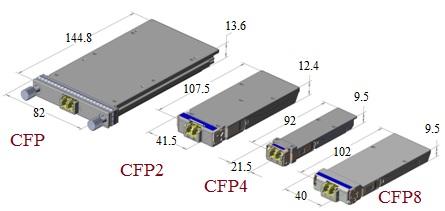CFP vs CFP2 vs CFP4 vs CFP8 Optical Transceivers: Key Differences
Advertisement
This article breaks down the key differences between CFP, CFP2, CFP4, and CFP8 optical transceivers commonly used in fiber optic networks.

Figure 1: Dimensions of CFP, CFP2, CFP4, and CFP8
The table below summarizes the specifications of each form factor:
| Specifications | CFP | CFP2 | CFP4 | CFP8 |
|---|---|---|---|---|
| Dimension (Width x Height x Depth in mm) | 82 x 13.6 x 144.8 | 41.5 x 12.4 x 107.5 | 21.5 x 9.5 x 92 | 40 x 9.5 x 102 |
| Number of pins used in electrical connection | 148 | 104 | 56 | 124 |
| DSP | Integrated DSP within package | No DSP in package, depends on Host Card | No DSP in package, depends on Host Card | No DSP in package, depends on Host Card |
| Power usage | <24 W | <12 W | <6 W | 24 W (Max.) |
| Number of lanes | 10 x 10G or 4 x 25G | 10 x 10G, 4 x 25G, 8 x 25G or 8 x 50G | 4x 10G or 4 x 25G | 16 x 25G, 8 x 50G |
In essence, the progression from CFP to CFP8 represents a trend towards smaller size, lower power consumption, and higher bandwidth capabilities. While CFP had an integrated DSP, later versions rely on the host card for DSP functionality, offering greater flexibility.
Advertisement
 RF
RF

